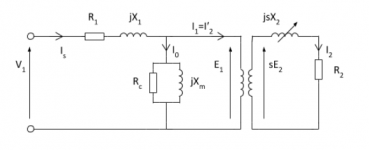Great, thanks! Is there an equation for this? I checked on Google, but couldn't find an equation relating the two.
Consider this simplified model of a motor, with the winding simplified to a rectangle:

In this motor, there are n windings in the wire loop with an area of A. A uniform magnetic field (B) points from the north pole to the south pole.
The motor rotates CCW as viewed from the top of the screen. Assign angle θ= 0 at the position shown, positive in the direction it rotates.
The magnetic flux at any given instant, is A*B*sin(θ). It's zero at the position shown, and its full value, 90 degrees from the position shown. The rate of change in magnetic flux which we'll need for Faraday's law, dΦ/dt is therefore: dΦ/dt = -A*B*cos(θ)*dθ/dt. With n windings, and rotation speed ω=dθ/dt, the back EMF that the winding produces, is n*A*B*ω*cos(θ). The commutator will put absolute value signs on the cosine term, when the brushes switch to the opposite stationary contacts, after the rotor spins past its stall point, 90 degrees from the position shown.
There will be a time-averaged value of this back-EMF that you will measure as the effective back-EMF of the motor. For this simplified model, the average value of abs(cos(θ)) = 2/π. Thus, the time-average of the back-EMF will be 2*n*A*B*ω/π. Real motors have more winding groups, to smooth out the operation, and eliminate the stall points.
This is the circuit diagram that models the electrical behavior of a motor winding. It is treated as a self-inductance (L) and resistance (R), in series with the motor's back EMF. The self-inductance (L) is what the winding would do, if it weren't part of a motor, and were just a stationary coil, reacting to changes in current. On net, the motor produces an ohmic voltage drop from the parasitic resistance, a back EMF from the coil's self-inductance, plus a back-EMF from the coil's motion in the motor's magnetic field.




